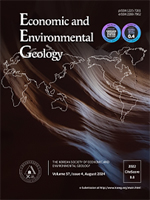고준위방사성폐기물 지층처분 암종 평가를 위한 경상분지 진주층 예비연구: 암상 및 광물학적 특성을 중심으로
Preliminary Study on the Jinju Formation in the Gyeongsang Basin to Evaluate Host Rock for High-level Radioactive Waste Geological Disposal: Focusing on Lithological and Mineralogical Characteristics
- 대한자원환경지질학회
- 자원환경지질
- 57권 4호
-
2024.08387 - 396 (10 pages)
-
DOI : 10.9719/EEG.2024.57.4.387
- 15

고준위방사성폐기물(High-level radioactive waste, HLW) 지층처분은 지하 심부의 안정한 지층에 폐기물을 영구 격리하는 것이다. 전 세계적으로 고준위방사성폐기물의 지층처분 암종으로 결정질암과 더불어 낮은 투수성을 가지며 이온을 흡착하여 핵종의 이동을 억제할 수 있는 점토광물을 다량 포함하는 이암(실트암과 점토암)이 고려되거나 선정 되고 있다. 국내의 다수 육상 퇴적분지에 이암이 분포되어 있으나 지층처분 암종 평가를 위한 암상 및 광물학적 연구는 매우 부족한 상황이다. 본 연구에서는 한국지질자원연구원에서 지층처분 암종 평가를 위하여 시추한 진주층 시추공(JBH-1, 7-754 m)의 이암의 분포 양상과 광물 조성을 연구 하였다. 더불어 고준위방사성폐기물 처분장으로 선정되어 다학제적 연구가 진행 중인 스위스 Opalinus Clay와 비교 분석하였다. 40% 이상의 점토광물을 포함하는 점토암은 진주층 시추공의 상부(7-350 m)에 두꺼운 두께로 다수 협재하는 특징을 보인다. 진주층 점토암의 점토광물 특성은 심도에 따른 변화를 보이지 않으나 장석 및 탄산염 광물의 함량과 조성은 차이를 보인다. 이러한 광물 특성 변동은 핵종 거동에 영향을 미치는 공극수의 조성과 암석역학적 특성 등에 심도별 차이를 야기할 수 있다. 진주층 점토암의 점토광물 함량은 Opalinus Clay와 유사하나 점토광물 조성에서 차이를 보인다. Opalinus Clay는 스멕타이트/일라이트 혼합층 광물을 포함하는 반면에 진주층 점토광물은 높은 매몰 온도에서 변질되어 형성된 일라이트가 우세하게 관찰된다. 본 연구 결과들은 국내 고준위방사성폐기물의 지층처분 암종 연구에 유용하게 활용될 수 있을 것으로 판단된다.
The geological disposal of high-level radioactive waste (HLW) involves permanently isolating the wastes in stable geological formations deep underground. Mudstone (siltstone and claystone) containing abundant clay minerals is proposed as a host rock for geological disposal of HLW because clay minerals have low permeability and high ion sorption/exchange capacity. Despite the widespread occurrence of sedimentary basins in Korea, there is a lack of evaluation of mudstone as host rocks for geological disposal. In this study, we utilized the JBH-1 borehole (7-754 m) obtained from the Jinju Formation to investigate the distribution trend and mineral compositions of mudstone. Additionally, we conducted comparative analyses with the Opalinus Clay in Switzerland considered as host rock of geological disposal of HLW. Claystone containing more than 40% clay minerals exhibit thick layers primarily in the upper section (7-350 m) of the JBH-1 borehole. While the clay minerals content of claystone does not show significant variation with depth, there are differences in the characteristics of feldspar and carbonate minerals. These mineralogical variations can led change in pore water chemistry and rock mechanical properties. The clay minerals content of claystone in the Jinju Formation is similar to that of the Opalinus Clay. However, there are notable differences in clay minerals composition. While the Opalinus Clay contains smectite-illite mixed-layer minerals, the Jinju Formation are dominated by illite indicating higher burial temperatures. This information will be useful for studying the host rock of HLW geological disposal site in Korea.
1. 서 론
2. 지질개요
3. 연구방법
4. 연구 결과 및 토의
5. 결론 및 제언
사 사
References
(0)
(0)